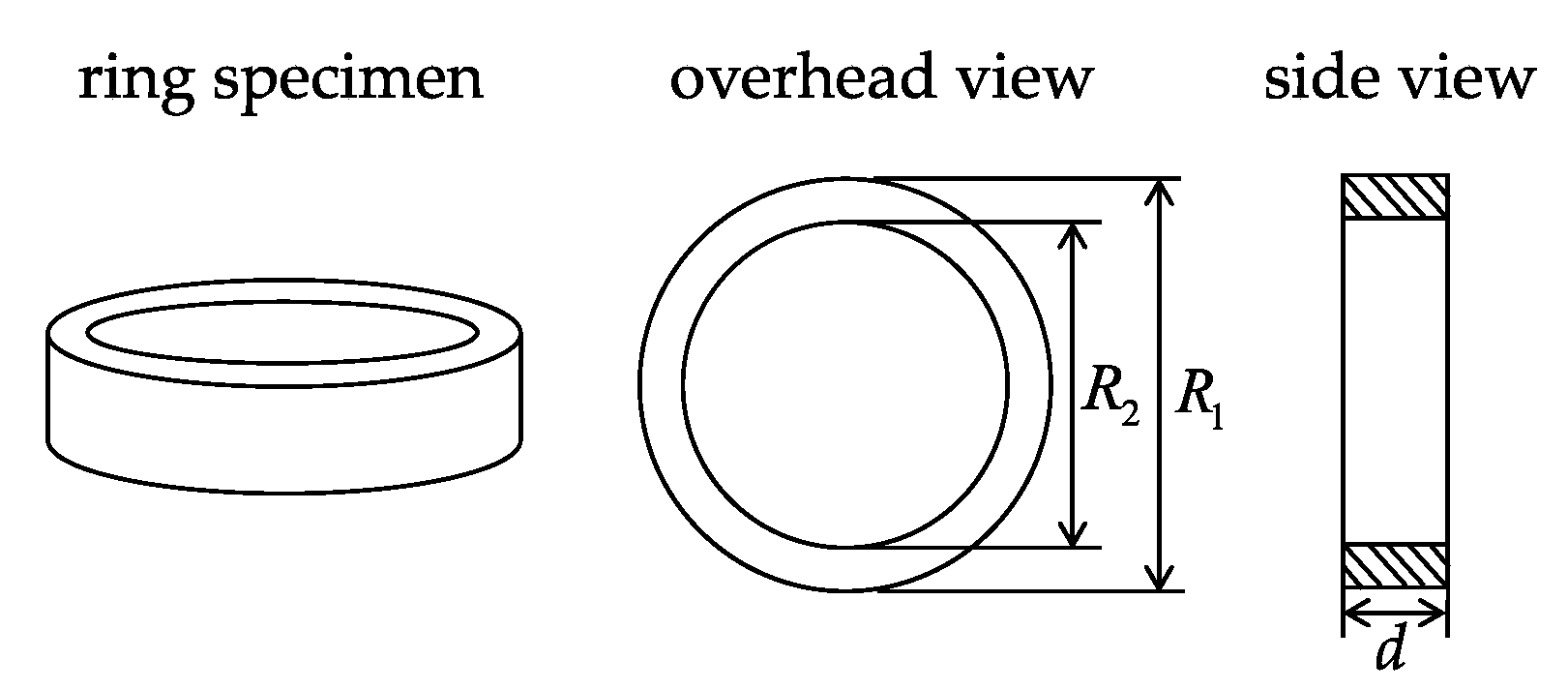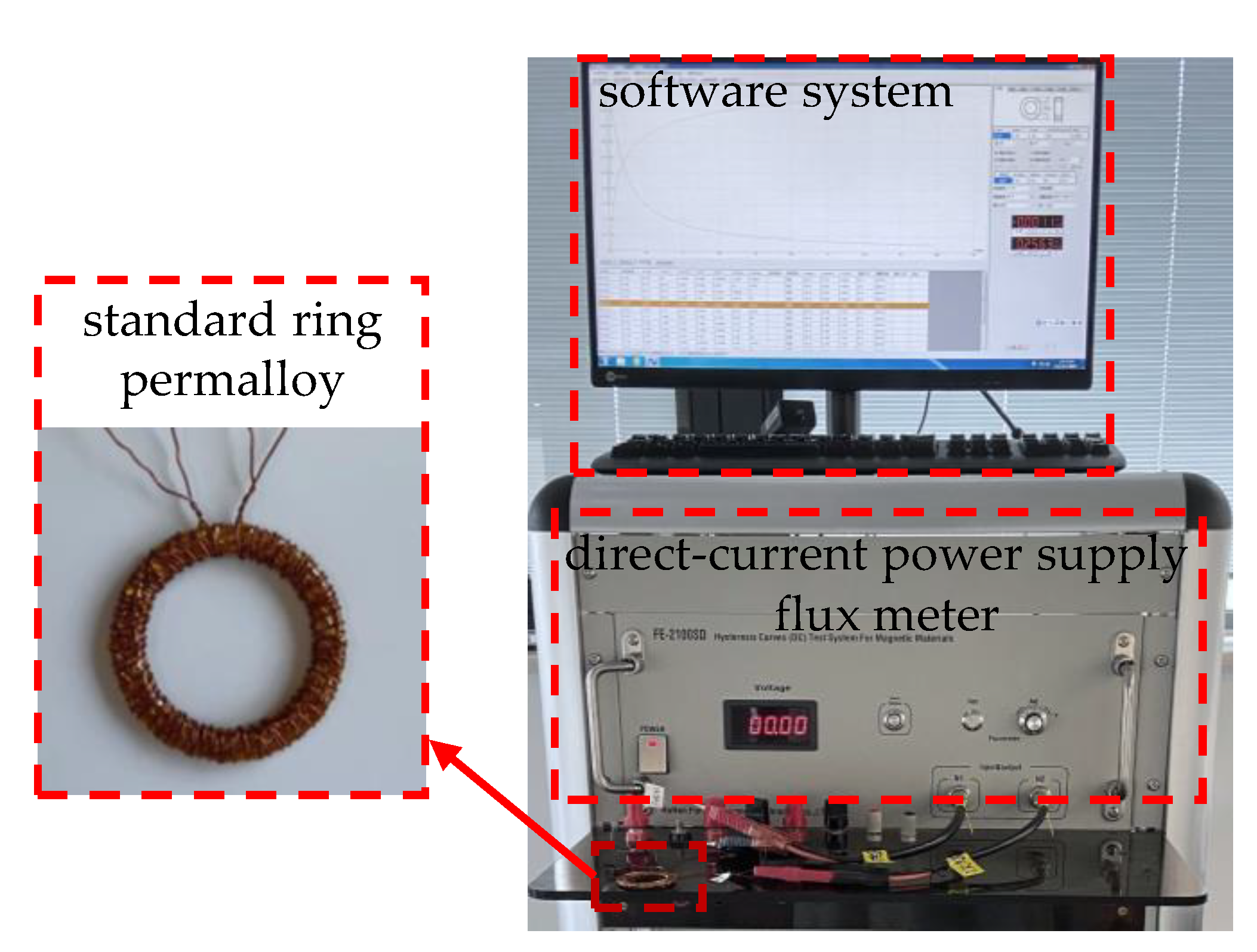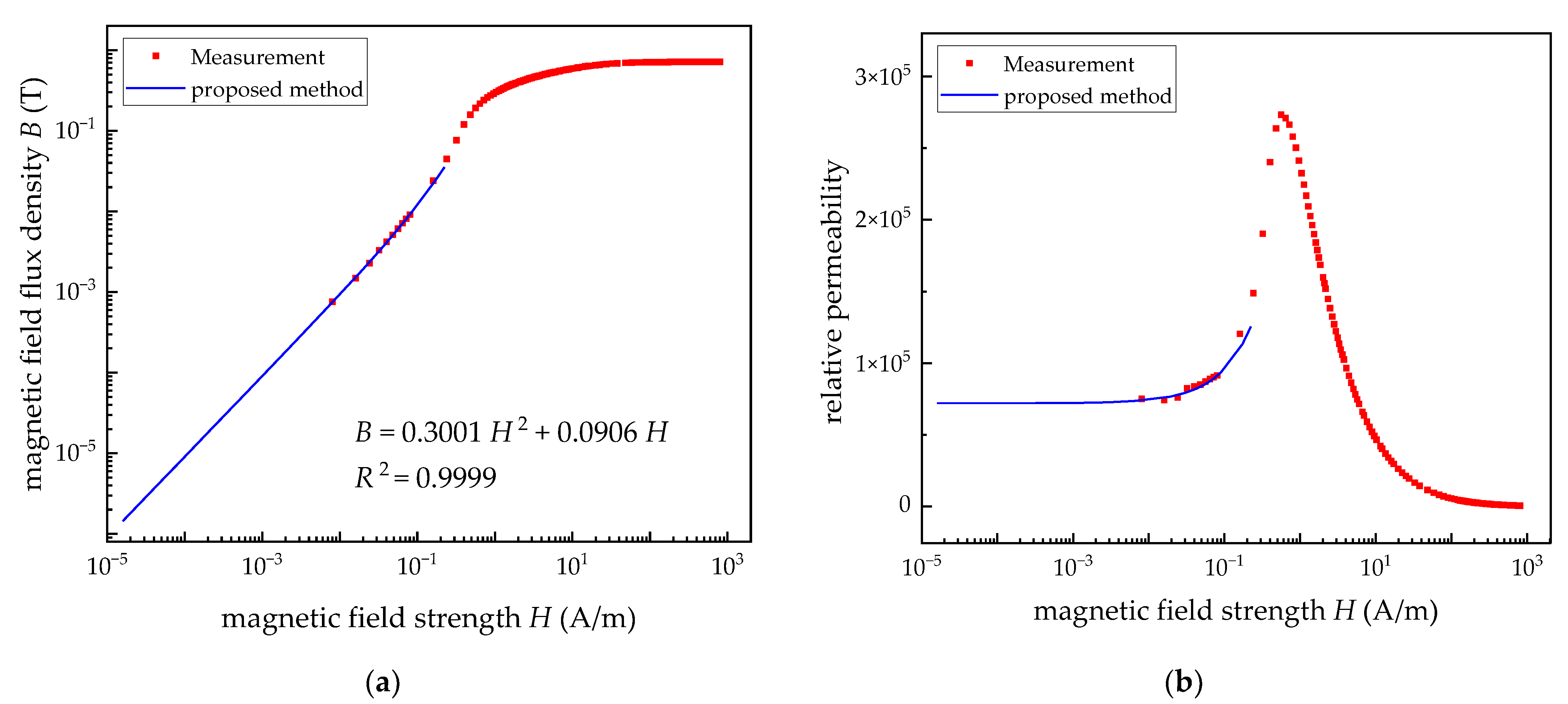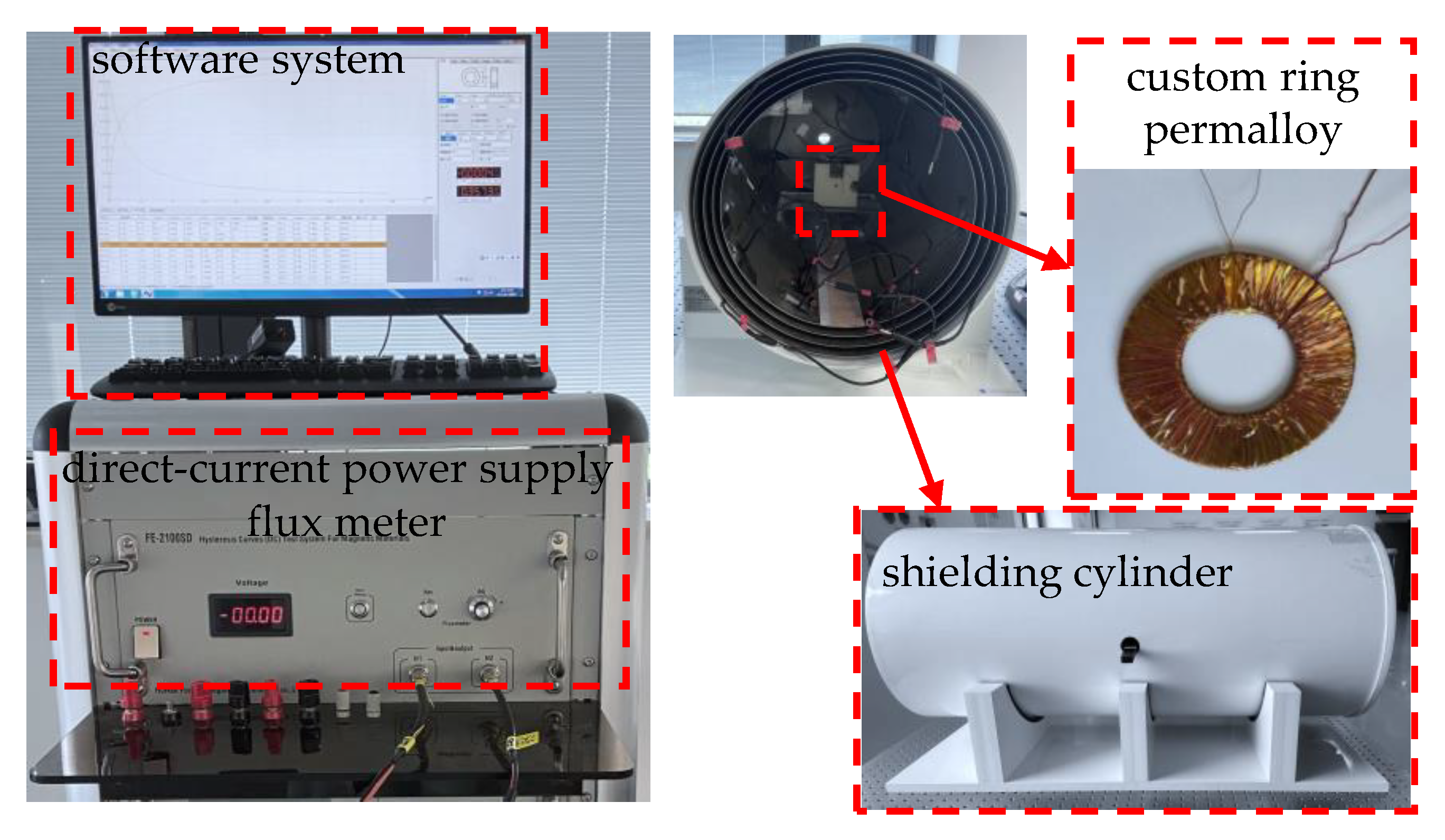A Method to Measure Permeability of Permalloy in Extremely Weak Magnetic Field Based on Rayleigh Model
Abstract
1. Introduction
2. Principle of Permeability Measurement
2.1. Rayleigh Model for Magnetic Material
2.2. The Measurement for Magnetic Material
3. Test Results and Discussion
3.1. The Test Method in EWMF Based on the Rayleigh Model
- The dimensions of the ring specimen (outer diameter A, inner diameter B, and height C) were measured using vernier calipers.
- The effective magnetic circuit length (Le) and cross-sectional area (Se) of the ring specimen were calculated according to the SJ/T10281 standard, and the turns of the primary and secondary windings were obtained according to the measured magnetic field range and Equations (3)–(8).
- The primary and secondary windings are wound around the ring specimen. Notably, the high-temperature resistant tape should be used for insulation between windings and ring specimen, and the secondary winding should be wound before the primary winding.
- The primary and secondary windings are connected to the power supply and the flux meter, respectively. The size of the measured ring, the turns of two windings, the range of magnetic field strength (H is set from 0.08 to 800 A/m) and other parameters are accurately set in the software. The value of the measured initial permeability corresponds to the one at the magnetic field strength of 0.08 A/m.
- Based on Equations (3) and (4), the B-H curve, the permeability curve and the parameters including initial permeability (µi) (H is 0.08 A/m) can be determined.
3.2. The Test Results and Discussion
- (a)
- Test and parameter identification results for the Rayleigh model
- (b)
- Verification for the proposed method
4. Conclusions
Author Contributions
Funding
Institutional Review Board Statement
Informed Consent Statement
Data Availability Statement
Conflicts of Interest
References
- Li, J.; Quan, W.; Han, B.; Wang, Z.; Fang, J. Design and Optimization of Multilayer Cylindrical Magnetic Shield for SERF Atomic Magnetometer Application. IEEE Sens. J. 2020, 20, 1793–1800. [Google Scholar] [CrossRef]
- Kvitkovic, J.; Patel, S.; Pamidi, S. Magnetic Shielding Characteristics of Hybrid High-Temperature Superconductor/Ferromagnetic Material Multilayer Shields. IEEE Trans. Appl. Supercond. 2017, 27, 1–5. [Google Scholar] [CrossRef]
- Packer, M.; Hobson, P.J.; Davis, A.; Holmes, N.; Leggett, J.; Glover, P.; Hardwicke, N.L.; Brookes, M.J.; Bowtell, R.; Fromhold, T.M. Magnetic Field Design in a Cylindrical High-Permeability Shield: The Combination of Simple Building Blocks and a Genetic Algorithm. J. Appl. Phys. 2022, 131, 093902. [Google Scholar] [CrossRef]
- Ates, K.; Carlak, H.F.; Ozen, S. Dosimetry Analysis of the Magnetic Field of Underground Power Cables and Magnetic Field Mitigation Using an Electromagnetic Shielding Technique. Int. J. Occup. Saf. Ergon. 2022, 28, 1672–1682. [Google Scholar] [CrossRef]
- Matsuzawa, S.; Kojima, T.; Mizuno, K.; Kagawa, K.; Wakamatsu, A. Electromagnetic Simulation of Low-Frequency Magnetic Shielding of a Welded Steel Plate. IEEE Trans. Electromagn. Compat. 2021, 63, 1896–1903. [Google Scholar] [CrossRef]
- Holmes, N.; Leggett, J.; Boto, E.; Roberts, G.; Hill, R.M.; Tierney, T.M.; Shah, V.; Barnes, G.R.; Brookes, M.J.; Bowtell, R. A Bi-Planar Coil System for Nulling Background Magnetic Fields in Scalp Mounted Magnetoencephalography. Neuroimage 2018, 181, 760–774. [Google Scholar] [CrossRef]
- Yang, J.; Zhang, X.; Han, B.; Wang, J.; Wang, L. Design of Biplanar Coils for Degrading Residual Field in Magnetic Shielding Room. IEEE Trans. Instrum. Meas. 2021, 70, 1–10. [Google Scholar] [CrossRef]
- Yang, K.; Wu, D.; Gao, W.; Ni, T.; Zhang, Q.; Zhang, H.; Huang, D. Calibration of SQUID Magnetometers in Multichannel MCG System Based on Bi-Planar Coil. IEEE Trans. Instrum. Meas. 2022, 71, 1–9. [Google Scholar] [CrossRef]
- Afach, S.; Bison, G.; Bodek, K.; Burri, F.; Chowdhuri, Z.; Daum, M.; Fertl, M.; Franke, B.; Grujic, Z.; Helaine, V.; et al. Dynamic Stabilization of the Magnetic Field Surrounding the Neutron Electric Dipole Moment Spectrometer at the Paul Scherrer Institute. J. Appl. Phys. 2014, 116, 084510. [Google Scholar] [CrossRef]
- Kuchler, F.; Babcock, E.; Burghoff, M.; Chupp, T.; Degenkolb, S.; Fan, I.; Fierlinger, P.; Gong, F.; Kraegeloh, E.; Kilian, W.; et al. A New Search for the Atomic EDM of 129Xe at FRM-II. Hyperfine Interact. 2016, 237, 95. [Google Scholar] [CrossRef]
- Tashiro, K.; Wakiwaka, H.; Matsumura, K.; Okano, K. Desktop Magnetic Shielding System for the Calibration of High-Sensitivity Magnetometers. IEEE Trans. Magn. 2011, 47, 4270–4273. [Google Scholar] [CrossRef]
- Zhao, J.; Ding, M.; Lu, J.; Yang, K.; Ma, D.; Yao, H.; Han, B.; Liu, G. Determination of Spin Polarization in Spin-Exchange Relaxation-Free Atomic Magnetometer Using Transient Response. IEEE Trans. Instrum. Meas. 2020, 69, 845–852. [Google Scholar] [CrossRef]
- Patton, B.J.; Fitch, J.L. Design of a Room-Size Magnetic Shield. J. Geophys. Res. 1962, 67, 1117–1121. [Google Scholar] [CrossRef]
- Mager, A. Grossräumige magnetische abschirmungen. J. Magn. Magn. Mater. 1976, 2, 245–255. [Google Scholar] [CrossRef]
- Mager, A. The Berlin Magnetically Shielded Room (BMSR), Section A: Design and Construction. In Biomagnetism; Erné, S.N., Hahlbohm, H.-D., Lübbig, H., Eds.; De Gruyter: Berlin, Germany; Boston, MA, USA, 1981; pp. 51–78. [Google Scholar]
- Bork, J. The 8-Layered Magnetically Shielded Room of the PTB: Design and Construction. In Proceedings of the Biomag 2000 12th International Conference on Biomagnetism, Espoo, Finland, 13–17 August 2001; pp. 970–973. [Google Scholar]
- Jin, S.; Kuwahata, A.; Chikaki, S.; Hatano, M.; Sekino, M. Passive Shimming of Magnetically Shielded Room Using Ferromagnetic Plates. IEEE Trans. Magn. 2022, 58, 1–5. [Google Scholar] [CrossRef]
- Zhao, Y.; Sun, Z.; Pan, D.; Lin, S.; Jin, Y.; Li, L. A New Approach to Calculate the Shielding Factor of Magnetic Shields Comprising Nonlinear Ferromagnetic Materials under Arbitrary Disturbances. Energies 2019, 12, 2048. [Google Scholar] [CrossRef]
- Li, J.; Quan, W.; Han, B.; Liu, F.; Xing, L.; Liu, G. Multilayer Cylindrical Magnetic Shield for SERF Atomic Co-Magnetometer Application. IEEE Sens. J. 2019, 19, 2916–2923. [Google Scholar] [CrossRef]
- Harakawa, K.; Kajiwara, G.; Kazami, K.; Ogata, H.; Kado, H. Evaluation of a High-Performance Magnetically Shielded Room for Biomagnetic Measurement. IEEE Trans. Magn. 1996, 32, 5256–5260. [Google Scholar] [CrossRef]
- Cohen, D. Large-Volume Conventional Magnetic Shields. Rev. Phys. Appl. 1970, 5, 53–58. [Google Scholar] [CrossRef]
- Liyi, L.; Zhiyin, S.; Donghua, P.; Jiaxi, L.; Feng, Y. An Approach to Analyzing Magnetically Shielded Room Comprising Discontinuous Layers Considering Permeability in Low Magnetic Field. IEEE Trans. Magn. 2014, 50, 1–4. [Google Scholar] [CrossRef]
- Yamazaki, K.; Kato, K.; Muramatsu, K.; Haga, A.; Kobayashi, K.; Kamata, K.; Fujiwara, K.; Yamaguchi, T. Incremental Permeability of Mu-Metal in Low Magnetic Fields for the Design of Multilayer-Type Magnetically Shielded Rooms. IEEE Trans. Magn. 2005, 41, 4087–4089. [Google Scholar] [CrossRef]
- Rayleigh, L. XXV Notes on Electricity and Magnetism. —III. On the Behavior of Iron and Steel under the Operation of Feeble Magnetic Forces. Philos. Mag. J. Seri. 1887, 23, 225–245. [Google Scholar] [CrossRef]
- Canova, A.; Freschi, F.; Giaccone, L.; Repetto, M. Numerical Modeling and Material Characterization for Multilayer Magnetically Shielded Room Design. IEEE Trans. Magn. 2018, 54, 1–4. [Google Scholar] [CrossRef]
- Canova, A.; Freschi, F.; Giaccone, L.; Repetto, M.; Solimene, L. Identification of Material Properties and Optimal Design of Magnetically Shielded Rooms. Magnetochemistry 2021, 7, 23. [Google Scholar] [CrossRef]
- Kachniarz, M.; Szewczyk, R. Study on the Rayleigh Hysteresis Model and Its Applicability in Modeling Magnetic Hysteresis Phenomenon in Ferromagnetic Materials. Acta Phys. Pol. A 2017, 131, 1244–1250. [Google Scholar] [CrossRef]
- Kachniarz, M.; Kołakowska, K.; Salach, J.; Szewczyk, R.; Nowak, P. Magnetoelastic Villari Effect in Structural Steel Magnetized in the Rayleigh Region. Acta Phys. Pol. A 2018, 133, 660–662. [Google Scholar] [CrossRef]





| Symbol | Quantity | Standard Ring |
|---|---|---|
| A | outer diameter | 40 mm |
| B | inner diameter | 32 mm |
| C | Thickness | 2 mm |
| N1 | turns of the primary winding | 60 |
| N2 | turns of the secondary winding | 20 |
| Symbol | Quantity | Custom Ring |
|---|---|---|
| A | outer diameter | 100 mm |
| B | inner diameter | 50 mm |
| C | Thickness | 1 mm |
| N1 | turns of the primary winding | 1 |
| N2 | turns of the secondary winding | 450 |
| Symbol | Fitting Function | µi | µ8 × 10−5 A/m * | Error Ratio * |
|---|---|---|---|---|
| Measurement | - | - | 71,876 | - |
| proposed method | B = 0.3001H2 + 0.0906H | 72,097 | 72,116 | 0.33% |
| Linear method | B = 0.1095H | 87,137 | 87,137 | 21.23% |
| Poly4 method | B = 3.5652H4 − 1.9207H3 + 0.4775H2 + 0.0865H | 68,834 | 68,864 | 4.19% |
| ExpGrow1 method | B = −0.020188 + 0.01559 | 78,757 | 78,787 | 8.77% |
Publisher’s Note: MDPI stays neutral with regard to jurisdictional claims in published maps and institutional affiliations. |
© 2022 by the authors. Licensee MDPI, Basel, Switzerland. This article is an open access article distributed under the terms and conditions of the Creative Commons Attribution (CC BY) license (https://creativecommons.org/licenses/by/4.0/).
Share and Cite
Sun, J.; Lu, Y.; Zhang, L.; Le, Y.; Zhao, X. A Method to Measure Permeability of Permalloy in Extremely Weak Magnetic Field Based on Rayleigh Model. Materials 2022, 15, 7353. https://doi.org/10.3390/ma15207353
Sun J, Lu Y, Zhang L, Le Y, Zhao X. A Method to Measure Permeability of Permalloy in Extremely Weak Magnetic Field Based on Rayleigh Model. Materials. 2022; 15(20):7353. https://doi.org/10.3390/ma15207353
Chicago/Turabian StyleSun, Jinji, Yan Lu, Lu Zhang, Yun Le, and Xiuqi Zhao. 2022. "A Method to Measure Permeability of Permalloy in Extremely Weak Magnetic Field Based on Rayleigh Model" Materials 15, no. 20: 7353. https://doi.org/10.3390/ma15207353
APA StyleSun, J., Lu, Y., Zhang, L., Le, Y., & Zhao, X. (2022). A Method to Measure Permeability of Permalloy in Extremely Weak Magnetic Field Based on Rayleigh Model. Materials, 15(20), 7353. https://doi.org/10.3390/ma15207353






